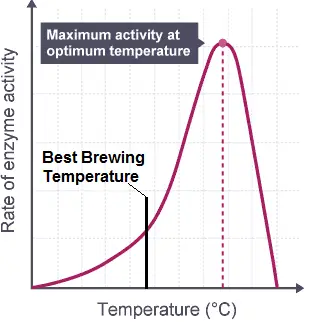How long does a pilsner take to ferment? As a brewer with years of experience, I can say that the fermentation process for a pilsner typically takes around 10 to 14 days.
However, there are several factors that can affect the duration of fermentation, such as temperature, yeast strain, and the overall health of the fermentation environment.
In this post, we will delve into the various aspects of pilsner fermentation and discuss how each factor can impact the timeline.
History and Characteristics of Pilsner
Pilsner is a type of pale lager that originates from the Czech Republic. It was first brewed in the city of Pilsen in 1842 and has since become one of the most popular beer styles in the world.

Pilsners are characterized by their light golden color, crisp flavor, and moderate alcohol content. The use of noble hops gives pilsners a unique floral and spicy aroma that sets them apart from other lagers.
The Pilsner Brewing Process
The process of brewing a pilsner involves several key steps, which include mashing, boiling, cooling, and fermentation.
The mashing process involves combining the grains with hot water to extract sugars needed for fermentation. Once the mashing is complete, the liquid is separated from the grains and brought to a boil.
During the boiling process, hops are added to the mixture to provide bitterness, flavor, and aroma.
After boiling, the liquid is cooled and transferred to a fermentation vessel, where yeast is added to begin the fermentation process.

This is when the yeast consumes the sugars and produces alcohol and carbon dioxide. Once fermentation is complete, the beer is typically transferred to a secondary vessel for conditioning and clarification before being bottled or kegged.
Primary Fermentation
The primary fermentation stage for a pilsner typically lasts between 10 to 14 days. During this time, the yeast consumes the majority of the available sugars and produces alcohol and carbon dioxide. The temperature during primary fermentation plays a crucial role in determining the fermentation timeline and overall flavor of the pilsner.
Temperature and Fermentation Speed
Pilsners are traditionally fermented at a lower temperature than other beer styles, typically between 50 to 55°F (10 to 13°C). This lower temperature results in a slower fermentation process, which allows the beer to develop the clean, crisp flavor profile that is characteristic of pilsners.

Fermenting at a higher temperature can speed up the fermentation process, but it can also lead to the production of unwanted off-flavors.
It’s important to maintain a consistent temperature throughout the fermentation process to achieve the best results.
Yeast Strain Considerations
The yeast strain used to ferment a pilsner can significantly impact the duration of fermentation and the final flavor profile of the beer. Some yeast strains are more efficient at fermenting sugars and can complete the process faster than others.
Lager yeasts are commonly used for pilsners due to their ability to ferment at lower temperatures and produce a clean, crisp flavor. However, some brewers choose to use ale yeasts for their pilsners, which can result in a slightly different flavor profile and a faster fermentation time.
Yeast Health and Pitching Rates
The overall health of the yeast and the amount used, known as the pitching rate, can also affect the fermentation timeline. Under-pitching can cause the yeast to become stressed, leading to a slow or stuck fermentation.
Over-pitching can result in an overly fast fermentation, which can produce off-flavors.
Ensuring that you pitch the appropriate amount of healthy yeast is essential for a successful fermentation and a high-quality pilsner.
Secondary Fermentation and Conditioning
After primary fermentation is complete, it’s common practice to transfer the beer to a secondary vessel for further conditioning and clarification.
This process, known as lagering, can last anywhere from a few weeks to several months, depending on the brewer’s preference.
During lagering, the beer is stored at a cooler temperature, typically around 35 to 40°F (2 to 4°C). This lower temperature helps to improve the beer’s clarity and enhance the clean, crisp flavor of the pilsner.
Conclusion
In conclusion, the fermentation process for a pilsner typically takes around 10 to 14 days, but this timeline can be influenced by various factors, including temperature, yeast strain, and yeast health.
Lagering can add additional time to the overall process, but it is essential for developing the desired flavor and clarity of a pilsner. Below are 10 key facts about pilsner fermentation to remember:
1. Pilsner fermentation typically takes 10 to 14 days.
2. Pilsners are fermented at a lower temperature (50 to 55°F) than other beer styles.
3. Maintaining a consistent temperature during fermentation is crucial for flavor development.
4. Lager yeasts are commonly used for pilsners, but ale yeasts can also be used.
5. The yeast strain used can impact the fermentation timeline and flavor profile.
6. Ensuring proper yeast health and pitching rates is essential for successful fermentation.
7. Primary fermentation is followed by secondary fermentation, also known as lagering.
8. Lagering takes place at a cooler temperature (35 to 40°F) and can last several weeks or months.
9. Lagering improves beer clarity and enhances the clean, crisp flavor of a pilsner.
10. The fermentation timeline can vary depending on factors such as temperature, yeast strain, and yeast health.
FAQs
What is the best temperature to ferment a Pilsner?
The best temperature to ferment a Pilsner is typically between 45°F (7°C) and 55°F (13°C). This range allows for the development of clean, crisp flavors while maintaining the delicate balance between malt and hops that is characteristic of this beer style.
How long should I ferment a lager?
The fermentation process for lagers typically takes several weeks, ranging from 2 to 6 weeks. The exact duration depends on various factors such as the specific lager style, yeast strain used, fermentation temperature, and desired flavor profile. It is crucial to follow a specific recipe or consult brewing guidelines to determine the optimal fermentation time for your lager.
How long should you ferment a Pilsner?
The ideal fermentation time for a Pilsner typically ranges from 2 to 4 weeks. However, it is important to note that fermentation time can vary depending on various factors such as yeast strain, fermentation temperature, and desired flavor profile. Monitoring the specific gravity and tasting the beer during fermentation can help determine the optimal time for fermentation completion.
What yeast is best for pilsner?
The best yeast for brewing a traditional pilsner is a lager yeast, specifically a Czech or German strain. These yeast strains ferment at cooler temperatures, typically between 45-55°F (7-13°C), which helps to develop the clean and crisp characteristics associated with pilsners.
What yeast for a crisper beer?
A popular yeast strain for producing crisp beer is the German lager yeast, specifically the Saccharomyces pastorianus strain. This yeast ferments at lower temperatures, resulting in a clean and crisp flavor profile with a smooth finish. Other yeast strains like American Ale yeast or Belgian Saison yeast can also contribute to a crisp beer, depending on the desired style and flavors.
How long should I lager a Pilsner?
Traditionally, Pilsners are lagered for a period of 4-6 weeks. This extended lagering time allows the beer to develop its characteristic clean, crisp, and smooth profile. During this time, the beer undergoes cold fermentation, which helps to refine flavors, clarify the beer, and reduce any off-flavors. It’s important to note that lagering times can vary depending on the specific recipe, yeast strain, and desired flavor profile.




